Milan Top Tourist Attractions & Area C
Area C is Milan’s congestion charge zone, covering most of the historic center, including iconic tourist attractions like the Duomo, Castello Sforzesco, and the Brera district. If you're driving to one of these places, there’s a good chance you’ll need to enter this area and pay the access fee.
For visitors arriving by car, it’s important to know which attractions fall within this area, not only to avoid unexpected charges but also to plan where to park and how to move around the city. In this article, we'll explore Milan’s top attractions and indicate whether they fall within Area C.
But first, let's take a closer look at area c.
What Is Area C?
Area C is a Limited Traffic Zone (ZTL) and a congestion charge area in central Milan. This means that most vehicles must pay a daily fee to enter during active hours, and access is restricted for certain vehicle types based on emissions. The zone operates Monday to Friday, from 7:30 a.m. to 7:30 p.m., and is monitored by cameras at all entry points.
It largely follows the path of the old city walls, known as the Cerchia dei Bastioni, and includes many of Milan’s most important historical, cultural, and commercial landmarks.
For details on ticket prices, check out our ticket costs article.
Why This Matters for Drivers
As mentioned earlier, most of Milan top attractions are located within Area C. This means that if you’re planning to visit places like the Duomo or the Galleria Vittorio Emanuele II by car, you’ll likely need to enter the zone and pay the daily access fee. Failing to do so can result in a hefty fine.
Knowing in advance whether your destination is inside the zone helps you:
- Decide whether to drive, take public transportation, or park outside Area C
- Plan your route to avoid unnecessary charges
- Purchase your ticket on time
Learn how to pay for Area C online , and discover how to activate your ticket.
What About Area B?
While this article focuses on Area C, it’s worth noting that all the attractions listed, whether inside or outside the zone, still fall within Milan’s larger limited traffic zone called Area B. This means that even if you don't have to pay the congestion charge, your vehicle still needs to meet certain environmental standards to enter the city. Area B is active on weekdays and enforced by cameras, so make sure your car is allowed before driving into Milan.
You can read our full Area B guide here to learn more about the zone’s rules, restricted vehicles, and how to avoid fines.
Top Milan Tourist Attractions: Inside or Outside Area C? the Full List
To make things easier, we’ve put the list right at the top. It shows whether each major attraction in Milan is located inside Area C or not, so if you’re planning to drive, you can quickly see which places require entering the congestion charge zone and which ones don’t.
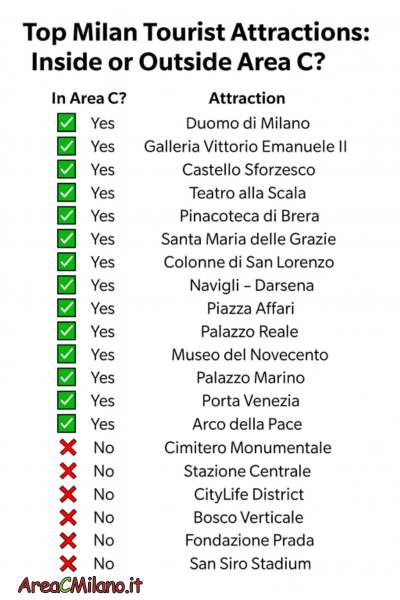
To help you visualize which attractions are located inside the zone, we’ve also included a map below. It highlights many of the most famous landmarks located within Area C, such as the Duomo, Sforza Castle, and La Scala Theatre.
This map focuses on the central part of Milan and includes nearly all of the top attractions that fall within Area C. However, some important sites outside the zone, like the Monumental Cemetery, Central Station, San Siro Stadium, and the Vertical Forest, are not shown here. These are located further out and may require different travel or parking considerations. If you're planning to visit places outside the map’s view, make sure to check their exact location and see whether your route passes through Area C or Area B. Also, keep in mind that, as you’ll see in the next chapters of this article, some attractions just outside the zone are very close to its borders, so when driving, it’s important to plan your route carefully to avoid entering Area C by mistake.
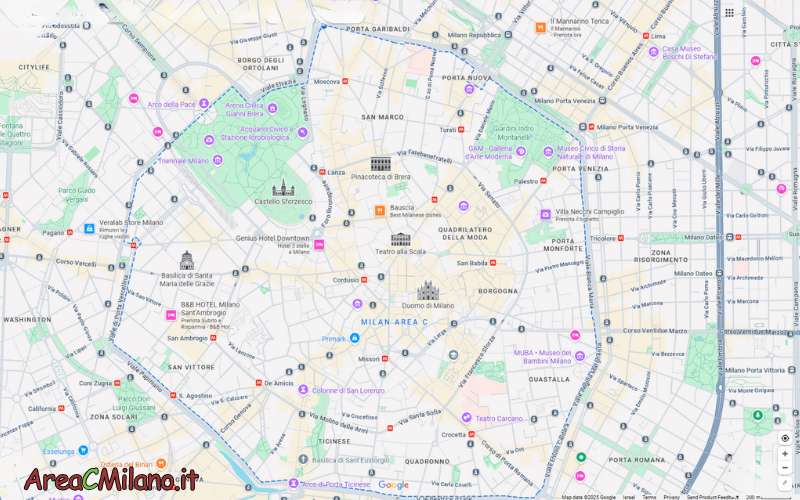
Major Attractions Inside Area C
The following attractions are all located within Area C, which means that if you plan to reach them by car, you’ll need to pay the congestion charge and make sure your vehicle is allowed under the access rules. This section gives you a quick overview of each attraction and why it’s worth a visit, especially if you're planning your route around the zone's restrictions.
Duomo di Milano
Milan Duomo or Milan Cathedral, as it is also known, is Milan’s most iconic landmark and a must-see for any visitor to the city. It is one of the largest cathedrals in Europe and a central point of the city’s layout. The building features an extensive Gothic exterior, a rooftop accessible to the public, and several notable artworks and historical features inside. Located in the heart of the city, it’s surrounded by other top attractions and easily reached by foot or metro.
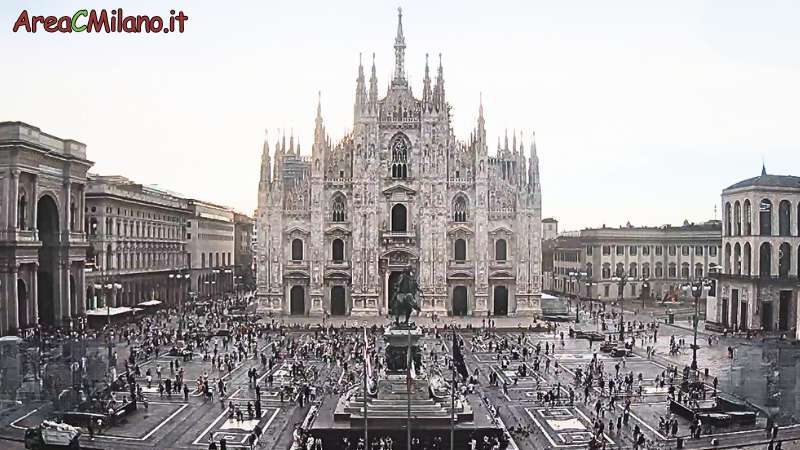
Galleria Vittorio Emanuele II
Located between Piazza del Duomo and Piazza della Scala, this 19th-century shopping arcade is known for its glass roof and mosaic floors. It houses a mix of cafes, restaurants, and high-end shops, and is a common stop for people visiting the center of Milan.
Castello Sforzesco
This historic fortress, once home to Milan’s ruling families, marks the entrance to Parco Sempione, one of the city’s largest green spaces. The castle houses several museums and art collections and is a short walk from many central landmarks, including the Duomo di Milano and Teatro alla Scala.
Teatro alla Scala
Located just north of the Duomo in Piazza della Scala, this opera house is one of the most well-known in the world. It has hosted performances by some of history’s most famous composers and artists, and remains an important cultural venue in Milan.
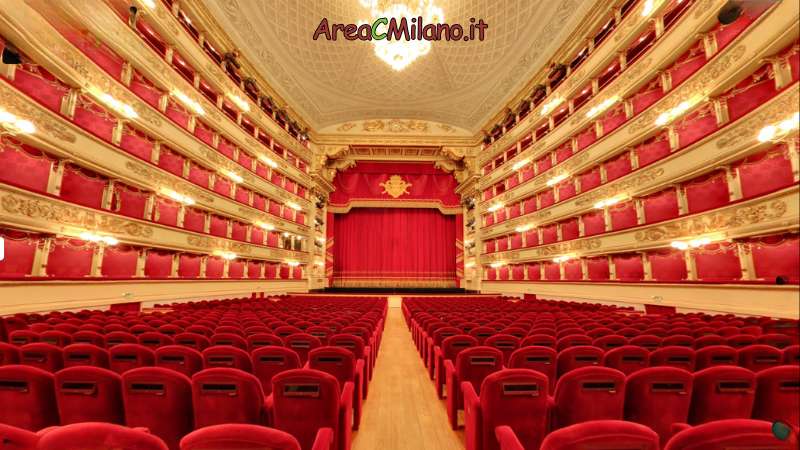
Brera Art Gallery (Pinacoteca di Brera)
Located in the Brera district, this gallery houses an important collection of Italian Renaissance and Baroque art, including works by Caravaggio, Raphael, and Mantegna. The area around the gallery is known for its narrow streets, small shops, and local restaurants.
Santa Maria delle Grazie (The Last Supper)
A UNESCO World Heritage site, this church is home to Leonardo da Vinci’s Last Supper, painted directly onto the wall of the convent’s former refectory. The building is also one of the finest examples of Renaissance architecture in Milan. While it is technically located inside Area C, it sits very close to the western edge of the zone. If you want to avoid entering the zone with your car, a practical option is to park nearby but outside its boundary and walk in.
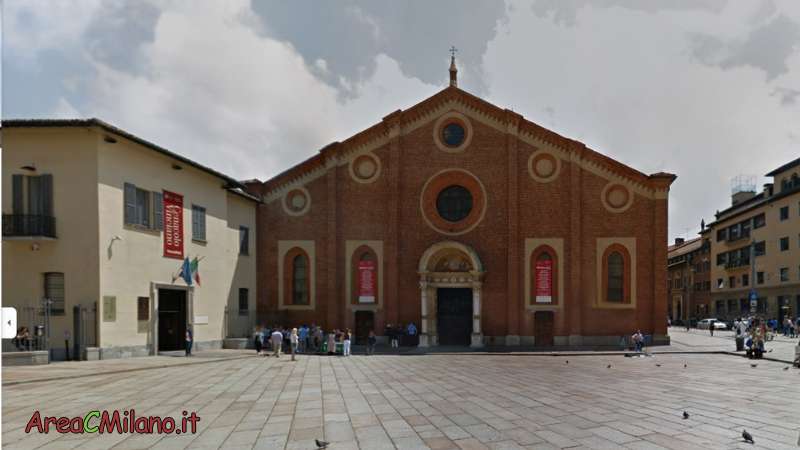
Colonne di San Lorenzo
These Roman columns, dating back to the 2nd or 3rd century, are among the oldest ancient remains in Milan. They stand in front of the Basilica of San Lorenzo, and the square around them has become a popular meeting point, especially in the evenings.
Piazza Affari
This square is best known as the location of Borsa Italiana, the Italian stock exchange. It’s also where you’ll find Maurizio Cattelan’s controversial sculpture L.O.V.E., often called “Il Dito.” The piazza is a short walk from Piazza Duomo and is part of Milan’s financial district.
Navigli (Darsena)
The Darsena is where the Naviglio Grande and Naviglio Pavese canals meet. It was once Milan’s main commercial dock and is now a central gathering place, especially in the evenings. While this part of the Navigli district is inside Area C, other stretches of the canals extend beyond the zone, so your access may depend on where exactly you’re going.
Attractions Outside Area C
While most of Milan’s major sights are within Area C, there are a few well-known places just outside the zone. If you're visiting any of the following by car, you won’t need to pay the congestion charge, as long as you stay outside the zone. Some of these locations are very close to the zone's boundary, so it’s a good idea to check your route carefully to avoid entering it by mistake. If you do end up crossing into the zone, you’ll need to purchase a valid ticket to avoid fines.
Cimitero Monumentale
Located just north of Area C, the Cimitero Monumentale is more than a cemetery, it’s also an open-air museum. Many of the tombs are designed by well-known architects and sculptors, and the grounds reflect a wide range of artistic styles from the 19th and 20th centuries. Because it's so close to the edge of the congestion charge zone, be careful when navigating by car, especially if you're approaching from the south or center. Double-check your route to make sure it doesn’t pass through the zone, unless you're prepared to pay the access charge.
Stazione Centrale (Central Station)
Milan’s main railway station is a major transit point for national and international trains. The building itself is also an example of monumental 20th-century architecture.
CityLife Shopping District & Skyscrapers
This newer development northwest of the center combines residential towers, office buildings, and a large shopping mall, all surrounded by green space. It’s one of Milan’s most modern urban areas.
Bosco Verticale (Vertical Forest)
These twin towers near Porta Garibaldi are covered in trees and vegetation and have become one of Milan’s most recognizable contemporary buildings. The surrounding streets are a mix of free-access and restricted roads, so it’s especially important to plan your route if you’re arriving by car. Approaching from the center or taking wrong turns nearby can easily lead you into Area C — so be cautious, and if you do enter, don’t forget to pay the congestion fee.
San Siro Stadium
San Siro is Milan’s main football stadium and home to both AC Milan and Inter football teams. Located in the northwestern part of the city, outside Area C, it’s one of the largest stadiums in Europe. While mainly known for hosting Serie A and Champions League football matches, it’s also used for concerts and other major events. The area around the stadium is not central, but it’s well connected by public transportation, including metro and bus lines.
How to Visit Attractions in Area C Without Driving In
Even if the attractions you want to visit are inside Area C, that doesn’t mean you have to drive into the zone to see them. There are several easy alternatives to reach the zone without paying the congestion charge or worrying about access restrictions:
- Park just outside Area C. Many parking garages and blue-line street parking spots are located right along the boundary of the zone. From there, you can walk into the city center or take a quick tram or metro ride.
- Use public transportation. Milan’s metro, tram, and bus network is extensive and reliable. Most lines pass through the historic center, making it easy to reach central attractions without a car.
- Try bike or scooter sharing. Services like BikeMi or shared electric scooters are available throughout Milan and can be a fun, flexible way to move around the city.
- Choose a hotel outside Area C. Staying just outside the zone allows you to avoid daily access charges while still being close to the city center. Many hotels in these areas offer easy access to public transport or walkable routes into the zone.
This approach not only saves you money, but also helps reduce traffic congestion and makes your visit more relaxed. You can enjoy Milan’s historic center on foot, just like the locals do, without worrying about ZTL boundaries.
For more help on where to leave your car, check out our dedicated Parking in Area C and Central Milan guide, where we break down parking options, pricing, and rules around the zone.